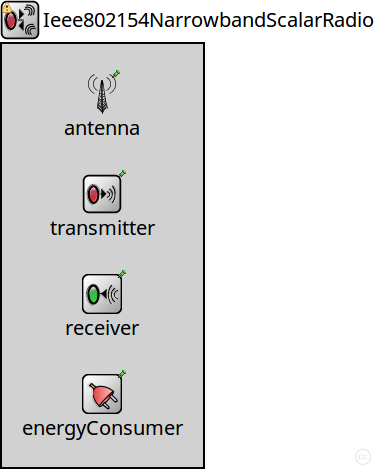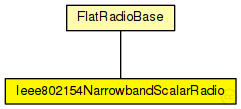 This documentation is released under the Creative Commons license
This documentation is released under the Creative Commons license(no description)

The following diagram shows usage relationships between types. Unresolved types are missing from the diagram.

The following diagram shows inheritance relationships for this type. Unresolved types are missing from the diagram.

| Name | Type | Description |
|---|---|---|
| FlatRadioBase | compound module |
This module servces as a base module for flat radio models. |
| Name | Type | Default value | Description |
|---|---|---|---|
| antennaType | string | "IsotropicAntenna" |
NED type of the antenna model |
| transmitterType | string | "Ieee802154NarrowbandScalarTransmitter" |
NED type of the transmitter model |
| receiverType | string | "Ieee802154NarrowbandScalarReceiver" |
NED type of the receiver model |
| energyConsumerType | string | "" |
NED type of the energy consumer model |
| radioMediumModule | string | "radioMedium" |
module path of the medium module where this radio communicates |
| energySourceModule | string | "" |
module path of the energy source module which provides energy to the radio |
| switchingTimes | string | "ms 0 0 0 0 0 0 0 0 0 0 0 0 0 0 0 0 0 0 0 0 0 0 0 0 0" |
time parameters to switch between radio modes |
| separateTransmissionParts | bool | false |
when enabled the transmission of preamble, header and data part are simulated separately |
| separateReceptionParts | bool | false |
when enabled the reception of preamble, header and data part are simulated separately |
| displayCommunicationRange | bool | false |
if true communication range is displayed as a blue circle around the node |
| displayInterferenceRange | bool | false |
if true interference range is displayed as a gray circle around the node |
| carrierFrequency | double | 2450 MHz |
center frequency of the band where the radio transmits and receives signals on the medium |
| bandwidth | double | 0.25 MHz |
bandwidth of the band where the radio transmits and receives signals on the medium |
| Name | Value | Description |
|---|---|---|
| class | Radio | |
| display | i=block/wrxtx |
| Name | Direction | Size | Description |
|---|---|---|---|
| upperLayerIn | input | ||
| upperLayerOut | output | ||
| radioIn | input |
| Name | Type | Unit |
|---|---|---|
| receptionStateChanged | long | |
| bitErrorRate | ||
| radioModeChanged | long | |
| transmittedSignalPartChanged | long | |
| packetReceivedFromUpper | cPacket | |
| receivedSignalPartChanged | long | |
| packetErrorRate | ||
| symbolErrorRate | ||
| packetSentToUpper | cPacket | |
| transmissionStateChanged | long | |
| listeningChanged | ||
| minSNIR |
| Name | Title | Source | Record | Unit | Interpolation Mode |
|---|---|---|---|---|---|
| receptionState | Radio reception state | receptionStateChanged | count, vector | sample-hold | |
| bitErrorRate | Bit error rate | bitErrorRate | histogram | ||
| radioMode | Radio mode | radioModeChanged | count, vector | sample-hold | |
| packetErrorRate | Packet error rate | packetErrorRate | histogram | ||
| symbolErrorRate | Symbol error rate | symbolErrorRate | histogram | ||
| transmissionState | Radio transmission state | transmissionStateChanged | count, vector | sample-hold | |
| minSNIR | Min SNIR | minSNIR | histogram |
module Ieee802154NarrowbandScalarRadio extends FlatRadioBase { parameters: antennaType = default("IsotropicAntenna"); transmitterType = default("Ieee802154NarrowbandScalarTransmitter"); receiverType = default("Ieee802154NarrowbandScalarReceiver"); carrierFrequency = 2450 MHz; // B_20dB ATmega256RFR2 (page 564) // *.bandwidth = default(2.8 MHz); // what is meant by bandwidth here? // the B_20dB bandwidth would lead to far too low BERs bandwidth = default(0.25 MHz); // 802.15.4-2006 (page 28) *.bitrate = default(250 kbps); // PHY Header, 802.15.4-2006 (page 43) // 4 octets Preamble // 1 octet SFD // 7 bit Frame length // 1 bit Reserved *.headerBitLength = (4*8 + 1*8 + 7 + 1) * 1 b; // RSSI sensitivity (ATmega256RFR2, page 566) receiver.energyDetection = default(-90dBm); // Receiver sensitivity (ATmega256RFR2, page 565) // TODO That is not quite true, because sensitivity // is defined as the input signal power that yields // a PER < 1% for a PSDU of 20 octets, but INET handles it // as minimum reception power. receiver.sensitivity = default(-100dBm); // There is no fixed boundary, because of the // DSSS and the capture effect. Taking the sensitivity minus some // arbitrary value as an approximate guess. receiver.minInterferencePower = default(-120dBm); // Minimum SNIR // -8 dB results into 98% PER for a PSDU of 20 octets receiver.snirThreshold = default(-8 dB); // TX Output power (typ. 3.5 dBm, ATmega256RFR2, page 564) transmitter.power = default(2.24mW); @class(Radio); }